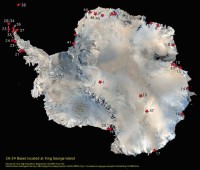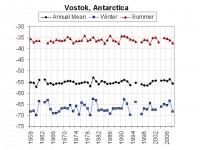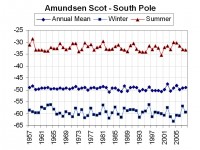By Meteorologist Art Horn
Much has been written of late about a new study out of the University of Washington about how Antarctica is not getting colder but is actually getting warmer. One of the authors is the Michael Mann. Enough has been said about his hockey stick, we all know about its shortcomings.
Recently I had a chance to question Mr. Mann at a talk he was giving in southwestern Connecticut. I asked him if he could explain how global average temperature had only gone up two out of the last seven decades even though eighty percent of all the carbon dioxide humans have put into the atmosphere has been since 1940? His response was that he disagreed with my figure of 80 percent since 1940, he said most of the carbon dioxide had been emitted in the last 15 years. He also was unaware that the global average temperature has only risen two of the last seven decades. He said that statement was simply not true. I can only guess he’s been looking at failed computer model forecasts and a broken hockey stick, not real data. It was quite stunning to hear his ignorance about the trend in temperature for the last seven decades.
Now as far as Antarctica warming goes I thought it would be instructive to actually look at some temperature data from the interior of the frozen continent. Enter Vostok station. Vostok was opened in the geophysical year in 1957 on December the 16th. Since then there has been an almost unbroken record of surface air temperature record. The station is located at 78 degrees 27 minutes south and 106 degrees 52 minutes east or about 780 miles from the South Pole. The station is number 15 in this image of Antarctica (fig 1).

See larger image here.
The station was opened by the Russians but now is run by the Russians, French and Americans. The mean temperature for Vostok in 1958 was -55.4 degrees Celsius. Ten years later in 1968 the mean was -55.7 degrees, slightly colder. Another 10 years goes by and in 1978 the mean at the station is -55.2 degrees, a bit warmer. By 1988 the mean temperature had risen a little to -55.1 degrees. During the 10 year period from 1978 to 1988 the world record low temperature of -129 degrees was reached at the station on July 21st 1983. By 1998 a year after the great El Nino of 1997 Vostok had a mean temperature of -56.6, a bit colder than 10 years earlier.
Last year the station had a mean temperature of -55.6 a little warmer or should I say less cold! The -55.6 is slightly colder by 0.2 degrees than the -55.4 recorded 50 years ago, not much warming going on here and in fact none. See the graph in figure 2 for a visual of how little change there has been at Vostok. Granted this is only one station but the fact remains that this is REAL DATA and not statistical game playing. The numbers speak for themselves. By the way on August 8th 2005 Vostok had an unofficial low temperature of -122 degrees, very cool indeed.

See larger image here.
Amundsen Scot AFB (figure 3) at the South Pole (#1 on the map) shows no real annual or summer warming also - with a slight (0.15C) winter cooling. The winter of 2004 was the coldest in the entire record as was the summer of 2000. Read full PDF here.

See larger image here.




